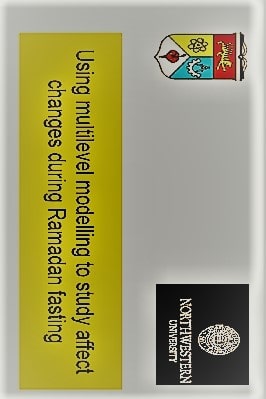USING MULTILEVEL MODELLING TO STUDY AFFECT CHANGES DURING RAMADAN FASTING – BOOK SAMPLE

| Changes During Ramadan Fasting |
| Joshua Wilt |
| 40 |
| |
| PDF Direct Download Link |
| Click for Hard Copy from Amazon |
Using multilevel modelling to study affect changes during Ramadan fasting – Book Sample
Brief introduction on fasting
Fasting in Ramadan – one of the pillars in Islam
Fast between dawn until sunset (duration varies across the globe & seasons) for about 29 or 30 days
No eating, drinking (of course, not the beer or wine!) and sexual relationship (for husband-wife) during day hours
Fasting as a test of obedience and patience
More rewards for existing obligatory rituals (e.g. 5 times daily prayer), good deeds and optional daily activities.
As a mean to attain taqwa (piety)
Two levels of fasting
• Ordinary level
• Higher level
Ordinary Level
No eating, drinking (of course, not the beer or wine!) and sexual relationship (for husband-wife) during day hours
At the same time, performing additional (recommended) prayer at night
Not really strict in controlling oneself from talking, looking or doing something less beneficials
When breaking the fast, eat a lot! and then sleep a lot.
Higher Level
No eating, drinking and sexual relationships during day hours
Strictly control the amount of eating when break the fast, & control eye sight – not to see or watch ‘bad’/’naughty’ things.
More involved in reciting Quran (complete reading of the whole Quran) and other religious obligations.
So, what do we expect the outcome of fasting?
- Pattern of emotion changes differ across weeks in Ramadan
- Higher level of positive emotion/traits
- Lower level of negative emotion/traits
- Muslim experience more of the changes as compared to the non-muslims
- Approaching end of Ramadan, happiness and joy may be higher
- Approaching end of Ramadan, moody and angry may be lower
Targeted aims of fasting
- To become more pious or religious
- To inculcate the religiousness within oneself
- To become a better person in life
Other benefits
As a mean to become more serene, calm, more patience, more empathetic, more religious, – psychologically (including emotion) more positive and healthier
–E.g. empathize the poor (by actual experiencing the hunger)
As a mean to rejuvenate the healthy body – physically and biologically healthier
Previous Studies
Afifi (1997) – people get more involved in stress reducing – reciting Quran
Mesbahzadeh et al (2005) – testosterone level was lower in Ramadan
Kadri et al (2000) – irritability higher among smokers in Ramadan
–People were more irritable at the end of Ramadan
Roky et al., (2000) – subjective alertness and mood decreased during Ramadan
Ali & Amir (1989) – fasting is likely reduce perceptual sensitivity.
Present Study
Based on the expected effects of Ramadan fasting, the hypotheses of the study are:
Hypothesis 1: During fasting month, levels of positive emotion and personality traits increase
Hypothesis 2: During fasting month, levels of negative emotion and personality traits decrease
Methodology
Daily record of emotion : prior, during and after Ramadan fasting.
Daily record started about 10 days before Ramadan and ended about 30 days after Ramadan
Students were told to record their daily emotion/feeling/mood without actually reminding them about the coming of Ramadan month – to avoid bias
Respondents
Total N = 164 undergraduate and postgraduate diploma
Muslim = 117 (71.3%), Non-Muslim = 47
(28.7%)
Male = 42 (25.6%), Female = 122 (74.4%)
Min age = 21.6, (from 18-42 yrs old)
Measure of Emotion
1=very low 2=low 3=slightly low 4=slightly high 5=high 6=very high
To read more about the Changes During Ramadan Fasting book Click the download button below to get it for free
or
Report broken link
Support this Website
for websites